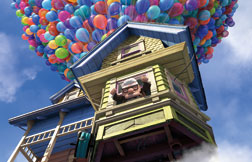LOS ANGELES – Karl Malden, the Academy Award-winning actor whose intelligent characterizations on stage and screen made him a star despite his plain looks, died Wednesday, his family said. He was 97.
Malden died of natural causes surrounded by his family at his Brentwood home, they told the Academy of Motion Picture Arts & Sciences. He served as the academy's president from 1989-92.
While he tackled a variety of characters over the years, he was often seen in working-class garb or military uniform. His authenticity in grittier roles came naturally: He was the son of a Czech mother and a Serbian father, and worked for a time in the steel mills of Gary, Ind., after dropping out of college.
Malden said he got his celebrated bulbous nose when he broke it a couple of times playing basketball or football, joking that he was "the only actor in Hollywood whose nose qualifies him for handicapped parking."
Malden won a supporting actor Oscar in 1951 for his role as Blanche DuBois' naive suitor Mitch in "A Streetcar Named Desire" — a role he also played on Broadway.
He was nominated again as best supporting actor in 1954 for his performance as Father Corrigan, a fearless, friend-of-the-workingman priest in "On the Waterfront." In both movies, he costarred with Marlon Brando.
Among Malden's more than 50 film credits were: "Patton," in which he played Gen. Omar Bradley, "Pollyanna," "Fear Strikes Out," "The Sting II," "Bombers B-52," "Cheyenne Autumn," and "All Fall Down."
One of his most controversial films was "Baby Doll" in 1956, in which he played a dullard husband whose child bride is exploited by a businessman. It was condemned by the Catholic Legion of Decency for what was termed its "carnal suggestiveness." The story was by "Streetcar" author Tennessee Williams.
Malden gained perhaps his greatest fame as Lt. Mike Stone in the 1970s television show "The Streets of San Francisco," in which Michael Douglas played the veteran detective's junior partner.
During the same period, Malden gained a lucrative 21-year sideline and a place in pop culture with his "Don't leave home without them" ads for American Express.
"The Streets of San Francisco" earned him five Emmy nominations. He won one for his role as a murder victim's father out to bring his former son-in-law to justice in the 1985 miniseries "Fatal Vision."
Malden played Barbra Streisand's stepfather in the 1987 film "Nuts;" Adm. Elmo Zumwalt Jr. in the 1988 TV film "My Father, My Son;" and Leon Klinghoffer, the cruise ship passenger murdered by terrorists in 1985, in the 1989 TV film "The Hijacking of the Achille Lauro."
He acted sparingly in recent years, appearing in 2000 in a small role on TV's "The West Wing."
In 2004, Malden received the Screen Actors Guild's Lifetime Achievement Award, telling the group in his acceptance speech that "this is the peak for me."
Malden first gained prominence on Broadway in the late 1930s, making his debut in "Golden Boy" by Clifford Odets. It was during this time that he met Elia Kazan, who later was to direct him in "Streetcar" and "Waterfront."
He steadily gained more prominent roles, with time out for service in the Army in World War II (and a role in an Army show, "Winged Victory.")
"A Streetcar Named Desire" opened on Broadway in 1947 and went on to win the Pulitzer Prize and New York Drama Critics Circle awards. Brando's breakthrough performance might have gotten most of the attention, but Malden did not want for praise. Once critic called him "one of the ablest young actors extant."
Among his other stage appearances were "Key Largo," "Winged Victory," Arthur Miller's "All My Sons," "The Desperate Hours," and "The Egghead."
Malden was known for his meticulous preparation, studying a script carefully long before he stepped into his role.
"I not only figure out my own interpretation of the role, but try to guess other approaches that the director might like. I prepare them, too," he said in a 1962 Associated Press interview. "That way, I can switch in the middle of a scene with no sweat."
"There's no such thing as an easy job, not if you do it right," he added.
He was born Mladen Sekulovich in Chicago on March 22, 1912. Malden regretted that in order to become an actor he had to change his name. He insisted that Fred Gwynne's character in "On the Waterfront" be named Sekulovich to honor his heritage.
The family moved to Gary, Ind., when he was small. He quit his steel job 1934 to study acting at Chicago's Goodman Theatre "because I wasn't getting anywhere in the mills," he recalled.
"When I told my father, he said, `Are you crazy? You want to give up a good job in the middle of the Depression?' Thank god for my mother. She said to give it a try."
In 2005, the U.S. Postal Service honored Malden by putting his name on a post office in Los Angeles to honor his achievement in film and his contributions to the Citizens' Stamp Advisory Committee, which meets to discuss ideas for stamp designs.
Malden and his wife, Mona, a fellow acting student at the Goodman, had one of Hollywood's longest marriages, having celebrated their 70th anniversary in December.
Besides his wife, Malden is survived by daughters Mila and Cara, his sons-in-law, three granddaughters, and four great grandchildren.
___
Associated Press writer Polly Anderson in New York contributed to this report.











































 9. MULTIPLE PERSONALITIES: This would be the first time Eddie played more than character, tackling Prince Akeem, Clarence the barber, Saul (the old white guy in the barber shop) and Randy Watson, the singer of the band Sexual Chocolate.
9. MULTIPLE PERSONALITIES: This would be the first time Eddie played more than character, tackling Prince Akeem, Clarence the barber, Saul (the old white guy in the barber shop) and Randy Watson, the singer of the band Sexual Chocolate. 5. ARSENIO CAN ACT: Even Arsenio Hall, the Bud Abbott of the '80s, shows some rare acting skills here. Whatever happened to him?
5. ARSENIO CAN ACT: Even Arsenio Hall, the Bud Abbott of the '80s, shows some rare acting skills here. Whatever happened to him? 2. "WE'RE BACK!" One of the funniest scenes: The "Duke Brothers" -- Randy and Mortimer -- from 1983's "Trading Places" are bums on the street until former co-star Murphy hands them a bag of money.
2. "WE'RE BACK!" One of the funniest scenes: The "Duke Brothers" -- Randy and Mortimer -- from 1983's "Trading Places" are bums on the street until former co-star Murphy hands them a bag of money. 